#a commentary on the modern world’s disturbing surveillance culture
Text

This is the Toho’s explanation for how the town found out about RetJ
#romeo et juliette#retj#toho retj#retj toho#i’m CRYING#and i thought hungarian romeo randomly kissing a servant was weird enough#but now i want it#i want this exact capulet to walk in mid aimer and snap a photo through his phone#and then back away slowly#not too unlike my fic#except i had sergio snap a picture while they were outside the church#honestly i’m here for it#who knows this may be fridge brilliance#a commentary on the modern world’s disturbing surveillance culture#it’s actually deep when you think about it#i would pay good money for someone to draw that scene#poor random capulet dude got a full dose of the aimer
12 notes
·
View notes
Text
The Rise of Dystopian Literature: Why We Are Drawn to Stories of Dark and Disturbing Futures
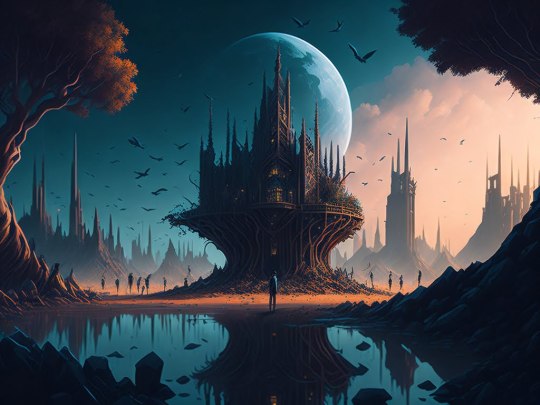
Outline:
I. Introduction
- Definition of Dystopian Literature
- The Growing Popularity of Dystopian Themes
II. Historical Roots of Dystopian Literature
- Early Examples and Influences
- Evolution of Dystopian Narratives
III. Characteristics of Dystopian Novels
- Common Themes and Elements
- Exploration of Societal Issues
IV. Impact of Dystopian Literature
- Shaping Cultural and Social Discourse
- Influence on Popular Culture and Media
V. Influential Dystopian Novels
- 1984 by George Orwell
- Brave New World by Aldous Huxley
- The Hunger Games by Suzanne Collins
- The Handmaid's Tale by Margaret Atwood
VI. Themes Explored in Dystopian Literature
- Surveillance and Loss of Privacy
- Totalitarian Governments
- Struggle for Individuality and Freedom
VII. The Allure of Dark and Disturbing Futures
- Human Fascination with Worst-Case Scenarios
- Reflection of Contemporary Fears and Anxieties
VIII. Dystopian Literature in Modern Education
- Inclusion in School Curriculums
- Encouraging Critical Thinking
IX. Dystopian Literature vs. Reality
- Parallels with Contemporary Issues
- Warning Signs and Societal Reflection
X. The Role of Technology in Dystopian Narratives
- Surveillance Technology in Literature
- Real-World Implications
XI. The Power of Dystopian Imagination
- Inspiring Change and Activism
- Catalyst for Social Awareness
XII. Criticisms and Controversies Surrounding Dystopian Literature
- Accusations of Dystopian Fatigue
- Ethical Concerns Regarding Graphic Content
XIII. Conclusion
- Recap of Dystopian Literature's Impact
- Continuous Relevance and Future Prospects
XIV. FAQs (Five Unique Questions)
- Is dystopian literature suitable for all age groups?
- How does dystopian literature differ from other speculative fiction genres?
- Can dystopian novels serve as a form of social commentary?
- Are there any emerging trends in contemporary dystopian literature?
- What makes dystopian literature a powerful tool for discussing societal issues?
The Rise of Dystopian Literature: Why We Are Drawn to Stories of Dark and Disturbing Futures
Introduction
Dystopian literature, characterized by nightmarish visions of the future, has witnessed a significant surge in popularity in recent years. This genre explores unsettling societal structures, oppressive governments, and the human struggle for survival. As we delve into the rise of dystopian literature, it's essential to understand the roots of this captivating genre and its enduring impact on readers.
Historical Roots of Dystopian Literature
Dystopian narratives have historical roots, with early examples found in works like "The Time Machine" by H.G. Wells. Over time, dystopian literature evolved, with authors weaving intricate tales that reflected contemporary fears and anxieties. The genre became a powerful medium to comment on societal issues, offering both cautionary tales and imaginative escapes.
Characteristics of Dystopian Novels
Dystopian literature shares common themes such as totalitarian regimes, loss of individual freedoms, and surveillance. These novels often serve as a lens through which readers can examine and critique societal norms. The exploration of dystopian worlds allows for a deeper understanding of the human condition and the consequences of unchecked power.
Impact of Dystopian Literature
Beyond entertainment, dystopian literature shapes cultural and social discourse. Influencing popular culture, movies, and television, dystopian narratives often transcend the pages of books, impacting how we perceive and navigate our own world. This influence extends to education, where dystopian novels are integrated into curriculums to provoke critical thinking.
Influential Dystopian Novels
Certain dystopian novels have left an indelible mark on literature and society. George Orwell's "1984," Aldous Huxley's "Brave New World," Suzanne Collins' "The Hunger Games," and Margaret Atwood's "The Handmaid's Tale" stand out as pillars of the genre, each exploring unique facets of dystopian themes.
Themes Explored in Dystopian Literature
Dystopian literature delves into recurring themes like surveillance, totalitarian governments, and the struggle for individuality. These themes resonate because they reflect genuine societal concerns, making dystopian narratives relatable and thought-provoking.
The Allure of Dark and Disturbing Futures
Readers are drawn to dystopian literature because it offers a glimpse into worst-case scenarios. The genre taps into human fascination with disaster, providing a space to explore fears and anxieties in a controlled setting. By examining these dark futures, readers can confront and, to some extent, prepare for potential challenges.
Dystopian Literature in Modern Education
The inclusion of dystopian literature in school curriculums enhances education by encouraging critical thinking. Students analyze complex societal structures, question authority, and draw parallels between dystopian narratives and real-world issues, fostering a deeper understanding of the complexities of human society.
Dystopian Literature vs. Reality
Dystopian literature often mirrors contemporary issues, acting as a warning sign for potential societal pitfalls. The genre prompts readers to reflect on the present, recognizing parallels between fictional dystopias and real-world challenges. This connection fosters awareness and, in some cases, inspires action.
The Role of Technology in Dystopian Narratives
Advancements in technology have become integral to dystopian narratives, with surveillance and loss of privacy playing central roles. Dystopian authors explore the implications of technology on society, offering insights into potential future scenarios that resonate with our current dependence on digital surveillance.
The Power of Dystopian Imagination
Dystopian literature goes beyond entertainment; it inspires change and activism. By presenting alternative futures, authors challenge readers to question societal norms, fostering a sense of agency to shape a better world. Dystopian imagination becomes a catalyst for social awareness and, potentially, positive transformation.
Criticisms and Controversies Surrounding Dystopian Literature
Despite its influence, dystopian literature faces criticisms, including accusations of dystopian fatigue and concerns about graphic content. Some argue that the genre's prevalence may desensitize readers to its warnings. Ethical considerations regarding the portrayal of violence and distressing scenarios also spark debates within literary circles.
books that changed my life
Embarking on a literary journey is not merely an act of reading; it's a transformative odyssey that has the power to shape our perspectives, challenge beliefs, and leave an indelible mark on our souls. As I reflect on the books that changed my life, I find myself immersed in a kaleidoscope of narratives that have altered the course of my understanding and enriched the tapestry of my experiences.
One such life-altering encounter was with Viktor Frankl's "Man's Search for Meaning." This profound exploration of human resilience, drawn from Frankl's experiences in Nazi concentration camps, instilled in me a newfound appreciation for the strength of the human spirit and the pursuit of purpose even in the face of unimaginable adversity.
Haruki Murakami's "Norwegian Wood" served as a poignant companion during moments of introspection. Its exploration of love, loss, and the delicate threads that connect us all resonated with the nuanced emotions I grappled with, offering solace and a deeper understanding of the human condition.
The philosophical musings of Hermann Hesse in "Siddhartha" guided me on a quest for self-discovery and spiritual enlightenment. The protagonist's journey echoed my own quest for meaning and purpose, prompting moments of introspection that reverberated long after the final page.
"1984" by George Orwell, a dystopian masterpiece, acted as a stark warning about the perils of unchecked power and the erosion of individual freedoms. Its chilling portrayal of a totalitarian regime left an indelible imprint, fostering a vigilant awareness of societal structures and the importance of safeguarding liberty.
Each book, a literary gem, has left an enduring legacy on my consciousness, shaping my thoughts, values, and understanding of the world. The transformative power of literature lies not just in the words on the page but in the profound impact it has on the reader's journey through life.
Conclusion
In conclusion, the rise of dystopian literature is not merely a trend but a reflection of our collective fascination with exploring the unknown, challenging societal norms, and contemplating the consequences of unchecked power. The enduring appeal of dystopian narratives lies in their ability to provoke thought, inspire change, and serve as cautionary tales for the complex world we inhabit.
FAQs (Five Unique Questions)
What are the 5 traits of dystopian literature?
Dystopian literature manifests through vivid characteristics that paint a bleak picture of the future. Typically, these traits include oppressive government control, societal dehumanization, environmental degradation, surveillance, and the suppression of individual freedoms. These elements collectively create a nightmarish vision of a world gone astray.
What is the most famous dystopian text ever written?
Undoubtedly, George Orwell's "1984" stands as the epitome of dystopian literature. Published in 1949, Orwell's masterpiece envisions a totalitarian regime, Big Brother's omnipresent surveillance, and the manipulation of truth, leaving an indelible mark on the genre and society's collective consciousness.
What describes dystopian?
Dystopian, derived from the Greek words "dys," meaning bad, and "topos," meaning place, encapsulates an imagined society characterized by oppressive social, political, and environmental conditions. These bleak settings often serve as cautionary tales, exploring the consequences of unchecked power and societal complacency.
What are the 4 types of dystopias?
Dystopias come in various shades, with common types being totalitarian, corporate, ecological, and technocratic. Totalitarian dystopias feature oppressive governments, corporate dystopias showcase unchecked corporate power, ecological dystopias depict environmental collapse, and technocratic dystopias explore the dark side of technological advancement.
What is a book that has changed society?
Harriet Beecher Stowe's "Uncle Tom's Cabin" is a pivotal work that significantly altered societal perspectives. Published in 1852, this anti-slavery novel ignited fervent discussions, heightened awareness of the horrors of slavery, and played a substantial role in galvanizing the abolitionist movement.
How has literature changed the world?
Literature acts as a mirror and catalyst for societal change. It sparks critical conversations, challenges norms, and fosters empathy. Books like "To Kill a Mockingbird" by Harper Lee and "The Diary of Anne Frank" have influenced public discourse, fostering social awareness and advocating for justice.
What is the most influential book in American history?
"The Federalist Papers," a collection of essays by Alexander Hamilton, James Madison, and John Jay, profoundly influenced American history. Penned in the late 18th century, these essays played a crucial role in shaping the U.S. Constitution, providing insights into the framers' intentions and political philosophy.
Which book is the most powerful book in the world?
"The Bible" is widely considered one of the most powerful and influential books globally. Its impact transcends religious boundaries, shaping cultural, ethical, and literary landscapes. Its narratives and teachings have left an enduring imprint on human history and continue to inspire countless individuals worldwide.
Read the full article
#6elementsofdystopianfiction#Booksthatchangedtheworldofliteraturepdf#booksthatchangedtheworldpdf#dystopianliteratureanalysis#Dystopianliteratureauthors#Dystopianliteraturebooks#Dystopianliteraturecharacteristics#dystopianliteratureexamples#dystopianliteratureineducation#Dystopianliteraturepdf#Dystopianliteraturesummary#dystopianliteraturevs.utopianliterature#dystopiannovelsforyoungadults#dystopianthemesandsymbolism#emergingdystopianauthors#exploringdarkfuturesinliterature#Famousdystopianliterature#Fictionbooksthatchangedtheworldofliterature#futuristicdystopiannovels#impactofdystopiannarratives#mostinfluentialbooksofalltime#mostinfluentialbooksofthe21stcentury#societalcritiqueindystopianfiction#thebookthatchangedtheworld#top10mostinfluentialbooksintheworld
0 notes
Text
Five books I'm looking forward to reading in 2022:





1. The Mere Wife by Maria Dahvana Headley
Two mothers—a suburban housewife and a battle-hardened veteran—struggle to protect those they love in this modern retelling of Beowulf.
From the perspective of those who live in Herot Hall, the suburb is a paradise. Picket fences divide buildings—high and gabled—and the community is entirely self-sustaining. Each house has its own fireplace, each fireplace is fitted with a container of lighter fluid, and outside—in lawns and on playgrounds—wildflowers seed themselves in neat rows. But for those who live surreptitiously along Herot Hall’s periphery, the subdivision is a fortress guarded by an intense network of gates, surveillance cameras, and motion-activated lights.
For Willa, the wife of Roger Herot (heir of Herot Hall), life moves at a charmingly slow pace. She flits between mommy groups, playdates, cocktail hour, and dinner parties, always with her son, Dylan, in tow. Meanwhile, in a cave in the mountains just beyond the limits of Herot Hall lives Gren, short for Grendel, as well as his mother, Dana, a former soldier who gave birth as if by chance. Dana didn’t want Gren, didn’t plan Gren, and doesn’t know how she got Gren, but when she returned from war, there he was. When Gren, unaware of the borders erected to keep him at bay, ventures into Herot Hall and runs off with Dylan, Dana’s and Willa’s worlds collide.
2. The Only Good Indians by Stephen Graham Jones
Seamlessly blending classic horror and a dramatic narrative with sharp social commentary, The Only Good Indians follows four American Indian men after a disturbing event from their youth puts them in a desperate struggle for their lives. Tracked by an entity bent on revenge, these childhood friends are helpless as the culture and traditions they left behind catch up to them in a violent, vengeful way.
3. The Broken Earth Trilogy by N. K. Jemisin (I know this is technically 3 books but I'm counting them as 1)
This is the way the world ends for the last time...
A season of endings has begun. It starts with the great red rift across the heart of the world's sole continent, spewing ash that blots out the sun. It starts with death, with a murdered son and a missing daughter. It starts with betrayal, and long dormant wounds rising up to fester.
This is the Stillness, a land long familiar with catastrophe, where the power of the earth is wielded as a weapon. And where there is no mercy.
4. Annihilation by Jeff VanderMeer
Area X has been cut off from the rest of the world for decades. Nature has reclaimed the last vestiges of human civilization. The first expedition returned with reports of a pristine, Edenic landscape; the second expedition ended in mass suicide, the third in a hail of gunfire as its members turned on one another. The members of the eleventh expedition returned as shadows of their former selves, and within weeks, all had died of cancer. In Annihilation, the first volume of Jeff VanderMeer's Southern Reach Trilogy, we join the twelfth expedition.
The group is made up of four women: an anthropologist; a surveyor; a psychologist, the de facto leader; and our narrator, a biologist. Their mission is to map the terrain, record all observations of their surroundings and of one another, and, above all, avoid being contaminated by Area X itself.
They arrive expecting the unexpected, and Area X delivers—but it’s the surprises that came across the border with them and the secrets the expedition members are keeping from one another that change everything.
5. The Icarus Girl by Helen Oyeyemi
Jessamy “Jess” Harrison, age eight, is the child of an English father and a Nigerian mother. Possessed of an extraordinary imagination, she has a hard time fitting in at school. It is only when she visits Nigeria for the first time that she makes a friend who understands her: a ragged little girl named TillyTilly. But soon TillyTilly’s visits become more disturbing, until Jess realizes she doesn’t actually know who her friend is at all. Drawing on Nigerian mythology, Helen Oyeyemi presents a striking variation on the classic literary theme of doubles — both real and spiritual — in this lyrical and bold debut.
116 notes
·
View notes
Link
The art of satire | Art & Culture “You can’t make up anything anymore. The world itself is a satire. All you’re doing is recording it.” — Art Buchwald Throughout history, satirists have reflected on the society that surrounds them. To be a satirist is to have a moral calling: to highlight the hypocrisies of a time. Works of satirical artists like Hogarth, Honore Daumier and Francico Goya have lived in history. The Georgian era marked the golden age for caricature in England. Through their work, artists have been illuminating and ridiculing the absurdities and follies of human beings. Using exaggeration as a tool, they have addressed pressing problems affecting their societies, including subjects that are usually taboo. The exhibition titled Diasporic Rhizome is a joint venture of satirical expression and clever mockery on display virtually. A project of 21 South Asian artists, it delves into topics like arrest of artists, journalist, writers and social workers; false accusations; women’s suffering; oppression; colonialism; killing of Muslims with the rise of Islamophobia; political unrest and racism in America that focuses exclusively on the voices of women of colour. The works are cryptic, surreal, disturbing and provocative. Sofia Karim’s Tribune Bagh is a stark satire against injustice and inequality. She and some fellow artists, poets and thinkers had organised Turbine Bagh, a protest at the Turbine Hall of Tate Modern Museum, London, as a gesture of solidarity by the diaspora. Tribune Bagh is a reference to Shaheen Bagh, the women-led protest in New Delhi that was the epicentre of the resistance prior to Covid-19 lockdown. The global protest is designed in the form of “samosa packets to show solidarity with Shaheen Bagh protest in India. The work highlights the anti-Muslim citizenship laws in Delhi, human rights situation (across India and Bangladesh), imprisoned artists, fascism and authoritarianism. A packet titled Release Abdul Kalam was a satire against the arrest of the photographer who photographed the refugees of Bashan Char island. The packet shows a photograph taken by Kalam, himself. In his collaborative project with Tariq Ali, Amin Rehman uses word art installation as his mode of expression. His work is a commentary on the effect of aggressive globalisation and decolonisation. The artist writes in his exhibition catalogue: “The installation is deep-rooted in rhizomatic thoughts and diasporas’ identity that serves as the pictorial content and interests in the phraseology of aggressive globalisation, colonisation and decolonisation. The installation challenges us to decipher the text layers through a shared interactional technique, like the palimpsest technique and plays with the cultural meaning embedded in superimposed or layered meaning typography. The work is suggestive of graphic and informational strategies reused in American pop art in the 1960s.” Rehman’s word art is a commentary on what appears to be truth on the surface, projected by modern media and lobbyists in global politics and social surroundings. The viewer is compelled to find the message hidden in the layers of his word installation. He provokes critical thinking and paints a picture through words. In an email interview, Amin says: “The pandemic and the necessary safety protocols have heavily affected the art community as it has taken away a large component of being able to show work in physical spaces. On the other hand, online discussions are more accessible… On a personal note, seeing the lives of others going through hard time, rising rates of poverty and death is mentally hurting.” Amin resides in Toronto. His upcoming exhibition The Bleeding Borders will be held at Art Gallery of Grande Prairie, Alberta, in the fall of 2021. Mapping Memory by Saba Karim and Shaheen Ahmad is about solidarity amongst global artists. Both are hopeful that artists will work towards more sustainable online collaborations during the pandemic. Through their work, they are “understanding transnational movements, migrations and friendship of artists in the three regions of Bangladesh, Pakistan and the UK”. Anamika Singh is an artist and designer based in New York. Her installation addresses the demolition of Osama bin Laden’s compound in Abbottabad. She writes in her catalogue: “As our landscapes are populated by military monuments, militarised urban infrastructure and networks of surveillance. How are our personal and shared histories folding themselves within dense entanglements of violent legacies? What grows in the voids left by methodical demolitions, site-less shrines and continually mutating and mediated memories?” Asma Kazmi’s Building the City of Exiles refers to the incident when a construction crane fell down on pilgrims in Makkah. She says humans around the globe are living under the shadow of idyllic skyscrapers, amongst health crises and inequality. “Uban space seems beholden to the aspirations of builders and planners who erect skyscrapers at alarming rates. Who and what is marginalised in this process? What is the toll on the environment?” Nitin Mukul, born in Lawrence, Massachusetts, is based in Queens, New York City. Her installation titled Blue Lake, With Live Performance can be experienced as a durational event. He begins his work with layers of paints placed in sheets of ice, freezing each layer of acrylic and oil so that they accumulate layers of color and texture. Placing the frozen mass outdoors, he allows it to melt according to weather conditions, filming the process with a tight zoom. Maryam Hina Hussain, born and raised in Karachi, now lives in London. She uses materials like textiles for her work. She enjoys using pigments to create the images. Spandita Malik, a New York-based artist from India, criticises the current global socio-political state of affairs with an emphasis on women’s rights and gendered violence. Her Nari comprises embroidered photographic portraits made in collaboration with women artisans from India. Her work documents the sacrifices of women confined in the so-called “safe spaces” of their homes , working day and night to embroider the cloth. Melissa Joseph’s Pocket Brass satirises the ‘pockets’ – metaphorically political spaces. Her work, a collection of animations and videos, focuses on her own experiences and imagination as a second generation Indian American. Pockets symbolise secrets, ownership, privacy and hidden sentiments. Once stolen, they lose value. Mara Ahmad, a US-based Pakistani artist, is interested in dialogue through physical and psychological borders. Showcasing the film titled: Le Mot Juste [Part One], she focuses on the languages she has learned and the concreteness of the syntaxes. Being able to speak three languages, she enjoys connecting the borders. Jaret Vadera’s Ascending to Outer Space to Find Another Race is influenced by Rorchtests, FMRI’s, info graphics kinetic science, science fiction, Buddhist philosophy and study of the impossible. It explores parallels between the internet and neural networks – search engines and memory. The viewer has to examine and experience the work in order to interactively manufacture the meaning. Diasporic Rhizome will remain on virtual display till May 15 at www.diasporicrhizome.com. The writer is an artist and educationist based in Lahore https://timespakistan.com/the-art-of-satire-art-culture/16433/?wpwautoposter=1618714827
0 notes
Text
Tony Oursler: Artist Profile
Tony Oursler is a multimedia and installation artist that one of my co-advisors introduced me too. The art powers that be appear to classify him as contemporary. I find a lot of his work to focus on the effects of technology and media on human consciousness and self perception. I like his use of irony and timeliness of his work. For myself the most relevant works he does are his more face centric ones, which came a bit mid career and are very prominent in his current portfolio.
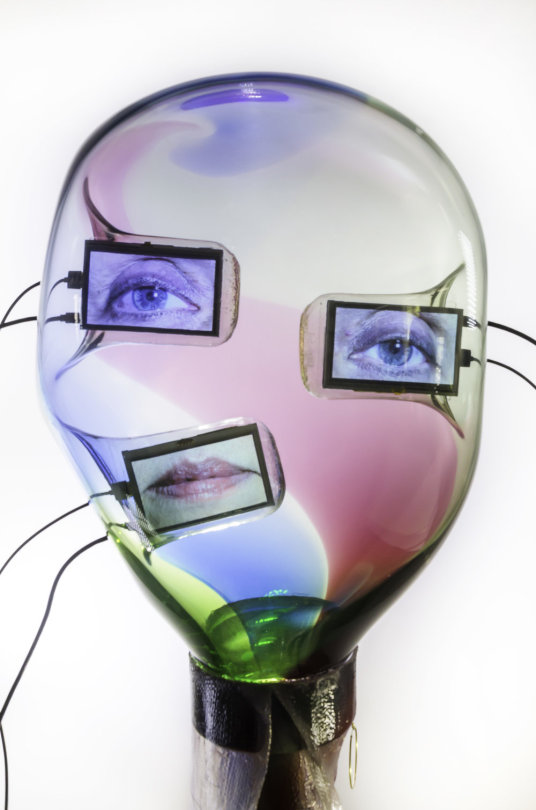
He does a lot of projection-form mapping. You see dummies with faces projected and making various commentaries on society in a hybrid of projection and performance art. This stretched much of his 90s portfolio.
I find these pieces uncanny and yet extremely interesting. They blow up the face and feature a limp body of just clothes and no appendages. They vary in proportionality and amounts of warping of the face.

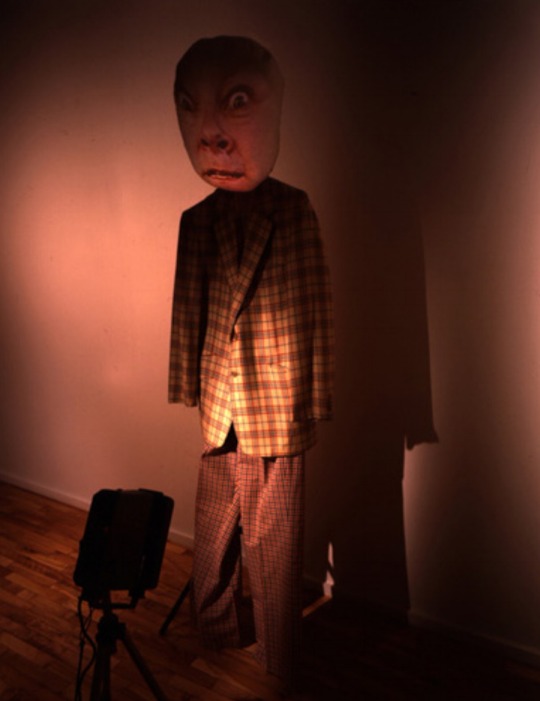


He even challenges form with this by matching faces with impossible bodies and forms and proportions.

It feels as though this marks an evolution from face-body to face within other form or dissection of the face in a composition of a piece.
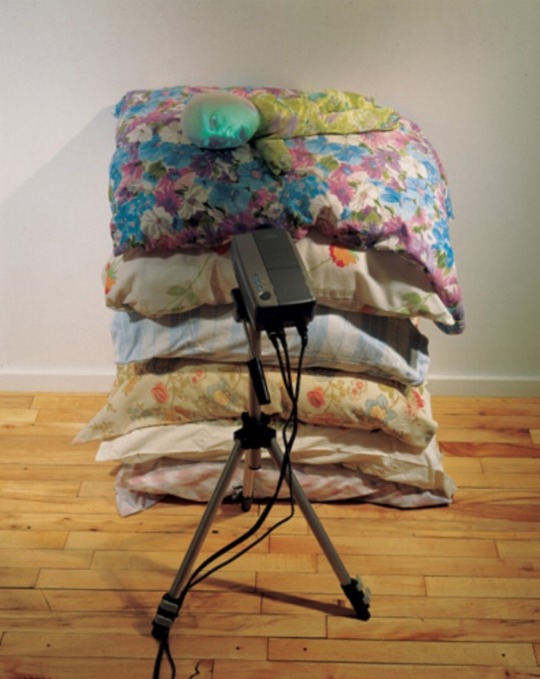
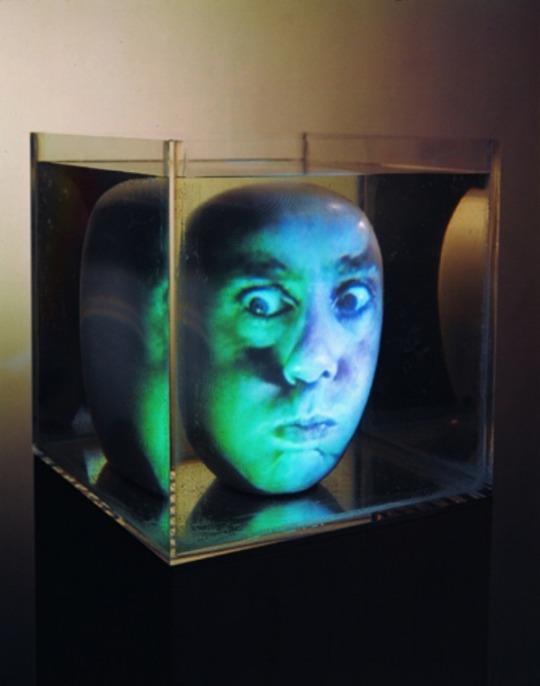

We see this extension of his doll and face work throughout the 90s. This page provides a more in depth review of it.
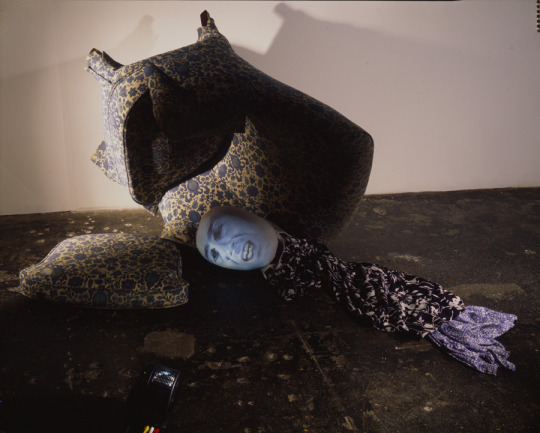
In the late 90s he departs from some of this to some TV and film art. One of his pieces that are a departure from his projected faces work is his Still Lives and Skulls.
I find this piece particularly interesting in how it bridges the face as identity and commentary into sacred ground.
“A face is a near sacred thing. Christians adore the vera icon, the perfectly flat and symmetrical image of Jesus’ face miraculously imprinted upon a cloth after Veronica wiped Christ’s brow as He ascended Golgotha, the Mount of the Skull. The face-skull opposition is one that interests Oursler (Mutation Skull, 1998; Hole, 1998), who comes from a religious background, and whose embrace of themes of dysfunction and countercultural subject matter may be seen as a response to his conservative roots. God has made us in His likeness.”
The likeliness argument rather than direct human facial form is very interesting to me.
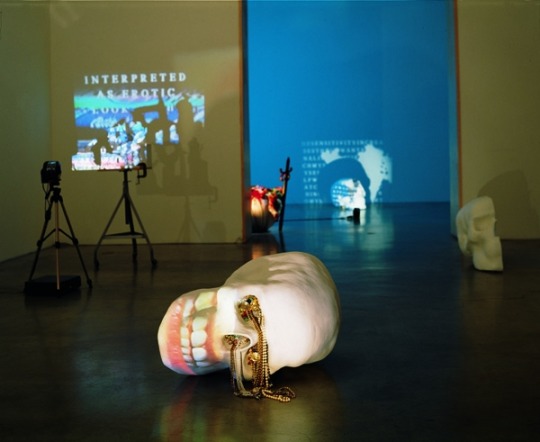



In the 2000s we start to see bigger installations from Oursler. One of my favorites is the Influence Machine.
Tony Oursler's The Influence Machine, installed at Madison Square Park, captured voices and images of ghosts, both contemporary and historical, creating a seance experience that recalled 19th-century sound and light projections. Oursler experimented with video, smoke machines, a variety of soundtracks, and several sculptural elements to explore the historical and current impact technologies have on our daily lives.


The 2000s were also an interesting time of his facial sculptures -- dissecting and collaging faces in various forms.

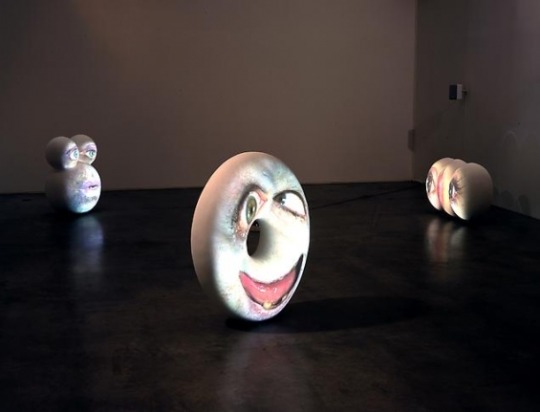
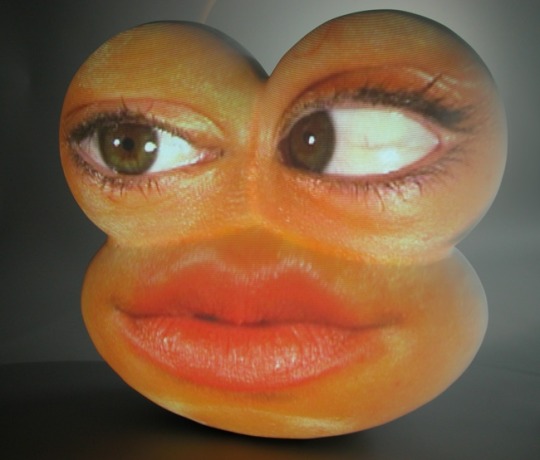
The later 2000s brought some archiectural scale projection works as well as exhibitions that centered around need, fractures, and commercialism. His 2008 exhibition in London is described on this page.
Lisson Gallery is pleased to present an exhibition by the American artist Tony Oursler. The show will use both gallery spaces to exhibit new installations and key earlier works. Oursler's practice explores a complex web of societal constraints and psychological dilemmas. The new body of work developed for this exhibition delves into the real/ fantastic morass of obsessive desires and needs, or the "reason" of the irrational.
I really enjoyed this exhibition and how the commentary was done in some of the pieces. It diverts a bit from the format of sculpture and strictly face.

He also did some interesting projection around money and currency, which I really liked, especially for 2008.

He has several pieces dedicated to obsession, consumerism, and phobia through the early 2010s and late 2000s. One is described here:
For this show, Oursler presents a variety of new works that take on technology, obsessive desires, phobias, socially acceptable addiction, and self-help culture. Large works feature Pop-inspired, outsized sculptural versions of everyday objects. They include an 8-foot long five-dollar bill with an eerily animated Abe Lincoln, a bottle featuring the artist as a modern-day genie, an enormous cell phone spewing disjointed snippets of conversations and a group of stark white columns transformed into a forest of smoldering cigarettes. These will be joined with a series of miniature architectural-model tableaux illuminated with projected performers that enact scripted existential dramas. Wall pieces that combine video and painting are inspired by image juxtapositions from internet searches and browser windows. Tony Oursler lives and works in New York and has had numerous project and survey exhibitions in institutions including the Metropolitan Museum of Art, New York; the Tate Gallery, London; the Los Angeles Museum of Contemporary Art; the Whitney Museum of American Art, New York; and the Musee de Jeu de Paume, Paris. He will present a show of new work at the Kunsthaus Bregenz later this year.
The 2010s also feature a number of interesting collaborations and large scale installations and exhibitions.
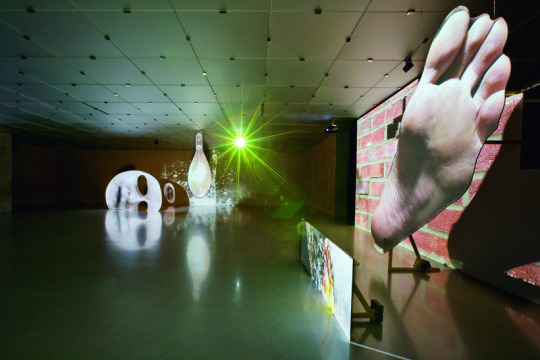

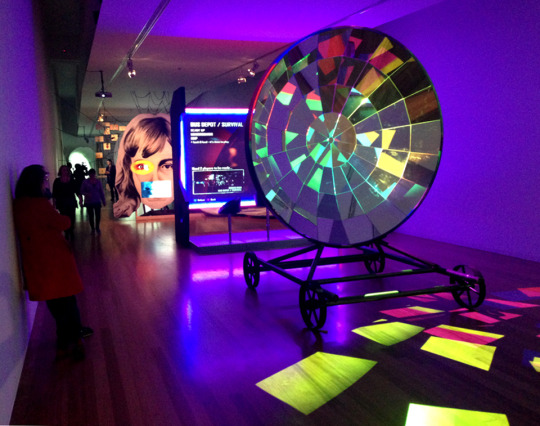


In 2015, Oursler shows a new piece in the UK centered around facial recognition called template/variant/friend/stranger.
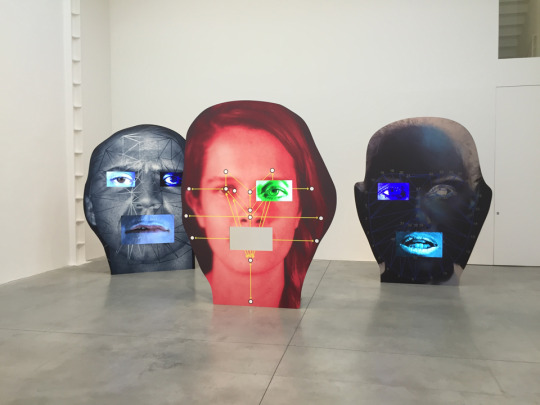
It is on this page and described as:
This solo exhibition of Tony Oursler, the artist's first of new work in the UK for over five years, centers around his fascination with the evolution of identity via techniques of facial recognition technology. Oursler explores the nuanced ramifications of these tools increasing ubiquity in daily life. The artist's interest in the face as the locus of communication and identity, through features, movement and expression, is central to these works. A series of seven imposing photographic painted and projected visages looms over the spectator in the main gallery, all but one punctured by video screens of eyes or mouths. One of part of this installation is an endlessly sifting projection of 150 algorithmically produced Eigen faces, revealing the beautiful yet distinctly nonhuman qualities of biometric analysis. One of the artist intentions is to "invite the viewer to glimpse themselves from another perspective, that of the machines we have recently created ". Each of these giant portrait heads bears the network of marks or nodes associated with different facial recognition systems, used by border controls, law enforcement agencies and even ATM machines. The images, staggered maze like throughout the space in the manner of theatrical props, present themselves as potential police mug shots, closed-circuit camera stills or anonymous faces in the crowd, albeit magnified in scale and distorted by their mediation through surveillance technology.
youtube
A variety of pieces in this vein traveled over 2015.



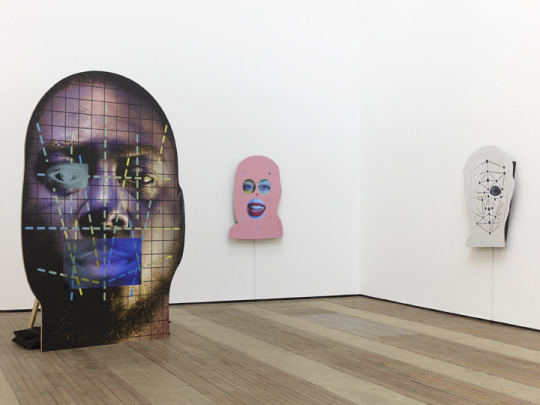
This line of work is described in a late 2015 exhibition:

His new show features several large aluminum panels in abstract shapes, resembling faces, each coated in a different reflective, metallic surface. Embedded with video screens depicting mouths and eyes, these visages also bear the marks and geometric patterns of algorythmic facial recognition mapping, combining human expression with electronic profiling. The intention of the artist is to invite the viewer to see himself through the eyes of the machines recently created by mankind. The increasing complexity and predomination of facial scanning in society is the key to comprehend Oursler's new works. These works raise questions about the biometric data in facial scans, iris patterns and fingerprints that all add to our invisible electronic profiles, amounting to a threatening accumulation of personal information on databases that categorize humans according to outward appearance, unique bodily features and even DNA sequencing. Through his new works Oursler doubts the purpose of teaching the machines to understand emotion, while exploring the evolution of human identity.

This multimedia approach to facial recognition defines much of his work between 2015 and 2018. I most agree with the statement on Tony’s page regarding what the works accomplish:
The hybrid faces are equally familiar and unnerving, piercing contemporary anxieties about privacy, surveillance, and identity. Oursler creates a sort of digital portrait in which we can see ourselves through the lens of machines we have recently created. The psychological dimension of human nature, which has long been an obsession of Oursler’s, is addressed here through his typical equation of imagery, sound and text.

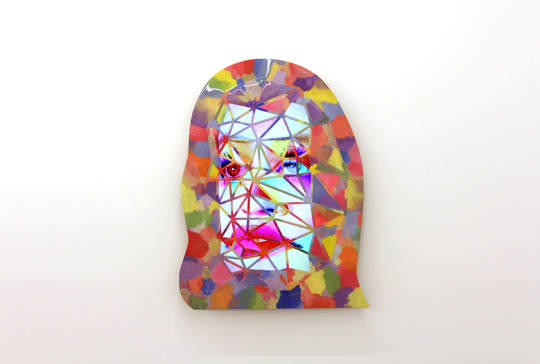

Staying in a similar vein 2017 and 2018 bring new sculptures of two new mediums for Oursler: glass and AI. They are beautiful and eery.
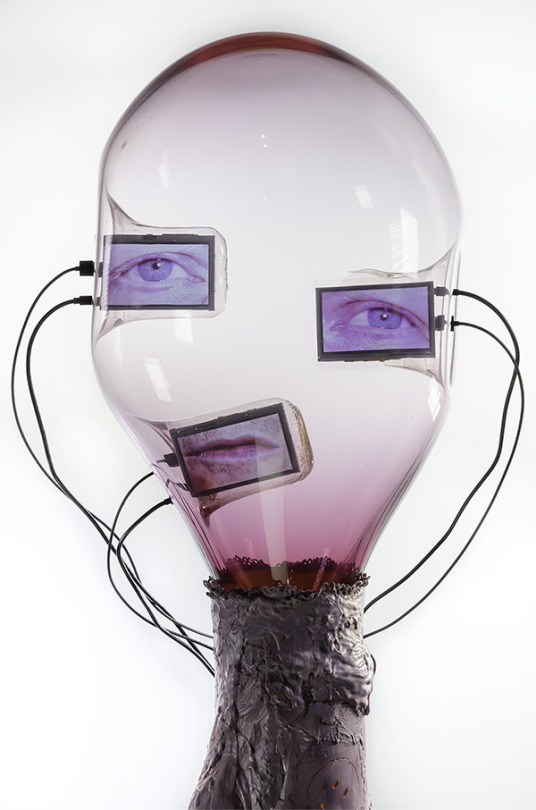
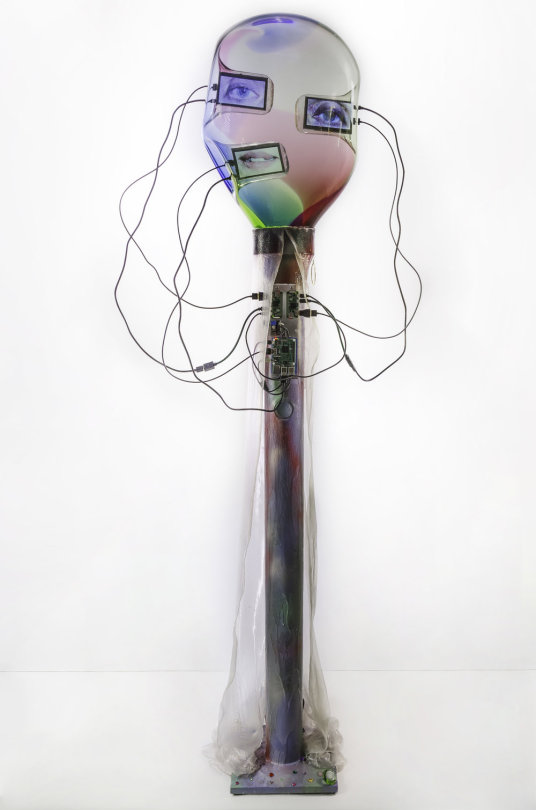

They are described here:
This exhibition depicts an inevitable world in which self-help, new age and motivational programs are fused or transferred to A.I.-systems, forming a low-fi singularity, with unforeseen, humorous and disturbing results.
These self-illuminating forms relate as much to the history of robotics as they do to camouflaged cellphone towers, video games and scarecrows. They play with the notion of how artificial intelligence may help us achieve our goals or not. They also question how these intelligences may choose to form physical identity through vestigial artifacts of humanity.
The freestanding bots are juxtaposed with wall mounted flow charts, which combine digitally moving images, painting, and sound. These works are based on schematics depicting motivational and inspirational systems, cognitive behavioral therapy, programing, networking to form a nexus of human desire, folly, and machine logic.
Artificial intelligence, or A.I., brings to light many questions regarding our coevolution with such systems. Most notably, will our creations replace us and become our final undoing? Or will we enter a utopian world of limitless knowledge and achievements? It is the artist’s perspective that in between these two questions, A.I has begun to enter our world in many fascinating and banal ways which are open to speculation.
Furthermore,
Artificial intelligence, or A.I., brings to light many questions regarding our co-evolution with technology. The artist sees technology as a reflection of our own ontologies, belief systems and desires. Will our creations replace us? Or will we enter a utopian world of infinite knowledge and achievements? It is the artist’s perspective that we are living between these two questions, A.I. begins to enter our world in many banal and fascinating ways leaving more space for speculation than answers.

2018 and 2019 bring back a variety of projection to his work, including some very large scale installs.
vimeo
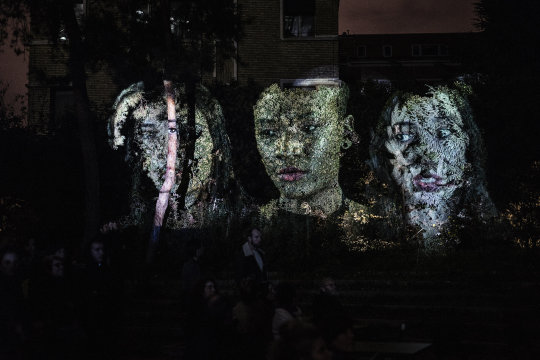
Overall Tony Oursler uses video, projection, sculpture, and other art to challenge us to think on our self perceptions and relationship with man made constructs and technologies. I think his ever evolving art that centers on the person and how society has changed has kept him relevant as he continues to pioneer new paths of experimentation and commentary in art.
0 notes
Link
Artist: Mona Hatoum
Venue: Chantal Crousel, Paris
Date: October 12 – December 21, 2019
Click here to view slideshow
Full gallery of images, press release, and link available after the jump.
Images:
Images courtesy of Chantal Crousel, Paris
Press Release:
Galerie Chantal Crousel is pleased to present Mona Hatoum’s 7th solo exhibition, from October 12 to December 21, 2019.
New sculptures, installations, and works on paper are presented.
Mona Hatoum’s art reflects on world conflicts, migrations, and surveillance, using materials as varied as steel, brick, concrete, and human hair, in order to create spaces of tension, paradox, and ambiguity. The motif of the grid and the sphere serve as metaphors for confinement, oppression, and destruction.
The artist articulates these issues through the use of abstraction and poetic Realism which enables her to reach a certain universality and become one of the most influential figures of her generation, as well as a role model for many contemporary artists.
From the point of creation to the placement of the work in the space, Mona Hatoum focuses her attention on the viewer’s body and on the precise moment when he or she encounters the work. Mingling the theme of everyday life with that of global instability, the artist creates a feeling of discomfort. Due to the familiarity of the forms and the poetics of the materials, Mona Hatoum’s works are attractive and irrepressibly lure the eye. Our attention is however disrupted when we approach the work as it reveals harsher and more precarious characteristics than is expected. Consider Remains (chair) V, a piece of furniture reduced to its ghostly charred remains, held together by wire mesh. This chair, a shadow of its former self, no longer suggests a refuge or comforting interior, but points to an alarming and disturbing situation.
The desire of the artist to combine geopolitical problematics with esthetical considerations leads to major works such as Concrete Mobile, Orbital II or Hot Spot (stand).
Hot Spot (stand) is a metal globe, wrapped in neon tube emitting a mesmerizing glowing red light. When approaching the work, one feels a sensation of heat and hears an unfamiliar electric buzz. Emblematic of Mona Hatoum’s work, the geographical map is here presented as a statement for a world embroiled in conflict and a territory in flux. For Orbital II, Mona Hatoum uses materials borrowed from the construction industry: the curved steel rebar forms a globe punctuated by clumps of concrete that also look like orbiting planets. Concrete Mobile is composed of the same elements this time suspended overhead. The precarious suspension of the concrete blocks suggests the erosion of a building that was once solid, down to a skeleton of fragments. Mona Hatoum produces a metaphor of a fragile world that is in a permanent state of destruction, while providing the key to a possible reconstruction. A Pile of Bricks also uses building materials. It consists of a pile of bricks that resemble a mobile architectural model and suggests a partially collapsed building with a caved-in façade.
The spatial relationships created by Mona Hatoum between those powerful works and the visitor generates a genuine visceral experience.
The grid is another theme explored in this exhibition. It initially became a recurring theme because of her interest in Minimalism and geometry. But the grid pattern has gradually evolved into a reference to real-life situations related to confinement. In a serial approach, Mona Hatoum repeats the motif in drawings on parchment paper entitled Drawing Heat. She produces a freehand drawing with a hot metal rod creating a form by removing material from the surface of the paper. For untitled (bed springs) I & II, an organic grid shape emerges. These lithographs were produced by using bedsprings, removed from the frame and applied directly to the stone, creating a variation on the classical form of the regular, geometric grid – which then seems to evaporate and evoke a possible liberation.
The body is the starting point for much of the artist’s commentary on the state of the world. However, it may also be the object. Since early days, Mona Hatoum explored the interiority of the body, often revealing its deepest intimacy. With some humor, while still seeking to elicit contradictory emotions, the artist once again uses the sphere in the work entitled Inside Out (concrete), whose surface pattern is reminiscent of the meanderings of the digestive system. In other sculptures, the artist incorporates materials discarded from her own body: a necklace made out of her own fingernails is displayed on a wooden bust (Nail Necklace) and for Silver Ball, rolled hair forms a large ball that is placed on a pedestal like a precious object. Other small works on paper created with hair punctuate the exhibition and encourage proximity between the artist and the visitor.
Lastly, SP Atelier extends an invitation to enter a wholly different sort of privacy, that of the artist’s studio. Mona Hatoum displays a set of drawings, photographs, embroideries, and other objects, collected during her residency in São Paulo in 2014. The elements that make up this installation are samples or preparatory sketches for pieces that emerged in São Paulo and were later presented in the exhibition that concluded the residency. The piece takes us behind the scenes of an artistic practice developing outside any fixed studio location, drawing sustenance from local materials and know-how.
As Clarrie Wallis wrote, “[Mona Hatoum] is highly sophisticated in her manipulation of materials and their metaphorical potential and, […] it is in her interface between these that the work’s meaning resides.”`
The visitor’s space is filled with tensions between form and content, medium and thought, latent poetry thus resulting, constitutes the strength of the artist’s work.
In 2019, Mona Hatoum has been awarded the Praemium Imperiale prize for Sculpture, submitted by Japan Art Association, the most historical cultural foundation in Japan.
She was presented with a number of other prizes during her career, such as the 10th Hiroshima Art Prize by Hiroshima City Museum of Contemporary Art (2017), Joan Miró Prize of the Fundació Joan Miró (2011), Honorary Doctorate from the University of Southampton (2010), or Roswitha Haftmann Stiftung Prize (2004) among others.
In 2015, her exhibition at the Centre Pompidou Paris travelled to Tate London, then to the Museum of Contemporary Art Kiasma in Helsinki (2016).
Her work has been shown in several solo exhibitions, in institutions such as the Menil Collection, Houston, U.S.A. (2017) that toured to Pulitzer Arts Foundation in St Louis, U.S.A. (2018); Hiroshima City Museum of Contemporary Art, Japan (2017); Fundación PROA, Buenos Aires, Argentina (2015); Pinacoteca do Estado, São Paulo, Brazil (2014); Museum of Fine Arts, Ghent, Belgium (2014); Arab Museum of Modern Art, Doha, Qatar (2014); Kunstmuseum St-Gallen, Switzerland (2013); Arter, Istanbul, Turkey (2012); Juan Miro Fundacion, Barcelona, Spain (2012); Ullens Center for Contemporary Art, Beijing, China (2009); Fondazione Querini Stampalia, Venice, Italy (2009); Museum of contemporary art, Sydney, Australia (2005); Hamburger Kunsthalle, Hamburg, Germany (2004), Kunstmuseum Bonn, Germany (2004), Magasin III, Stockholm, Sweden (2004); Museo de Arte Contemporáneo de Oaxaca, Mexico (2003); Centro de Arte de Salamanca, Spain (2002).
1. Mona Hatoum, Pinacoteca do Estado de São Paulo, São Paulo, Brésil, December 6–March 1, 2014.
2. Clarrie Wallis, Materials and Making, Mona Hatoum, Tate Publishing, April 2016, page 134.
Link: Mona Hatoum at Chantal Crousel
Contemporary Art Daily is produced by Contemporary Art Group, a not-for-profit organization. We rely on our audience to help fund the publication of exhibitions that show up in this RSS feed. Please consider supporting us by making a donation today.
from Contemporary Art Daily http://bit.ly/2LcaOJY
0 notes
Text
BEHOLD! The Modern Identity: Endnotes for us anal retentive readers.
(1) T.S. Eliot’s high modernist poem The Wasteland represents the modern world as a “scene of ruin.” (1921-1922) He used the imagery found in the crucifixion of Christ and a ruined church building after WWI, relating them to the then decay of Eastern Europe following the war. He posits an end to the meaning of the Christian consciousness, which at one time, was firmly grasped by the Church’s authority. That authority became “fragments” that were “shored against” what Eliot’s depicted as the “ruins” left behind after the “Thunder” of war’s past (Eliot Line 431).
(2) Pablo Picasso’s 1937 Painting of Guernica accurately depicts the fragmentation of the physical and abstract of the modern world. He illustrated the Spanish Civil War test bombing’s killing of Guernica’s peoples, creating a modern world that was broken apart. It was a world losing its grasp on previously believed tenets and morals. This applied to the physical devastation found in the Guernica bomb testing grounds. It also depicted the doing away with traditional means of coherent artistry to get across the message of the atrocity.
(3) Iain McGilchrist’s The Master and His Emissary: The Divided Brain and the Making of the Modern World presents the argument that the modern and post-modern world indeed has become fragmented, in that it has become more left hemisphere oriented. The Left-Hemisphere is found to fragment and group stimuli. The right hemisphere, on the contrary, contra-laterally is more concerned with the interconnectedness of the world it exists in. It also is the determiner of meaning. He posits that within the 6th and 15th/16th century, there was a balance between these two hemispheres. However in the modern and post-modern world, there is a neurological disposition toward the technical, governmental control of things: a left-hemisphere operation that has negatively affected humanity’s psychology and events over the past century.
(4) McGilchrist denotes that the left and right hemisphere’s of the brain give us two versions of the world. He notes that the Right Hemisphere gives an embodiment of and for the world (I am my body), whereas the left is aware of the world objectively in detachable parts (I have a body). Another way of seeing this: the right says “I am my self” and the left says “I am a self.” This juxtaposition between right and left qualifies the difference between personhood (embodiment) and consciousness (awareness). He notes on how language is exemplary of this facet: “Some languages, such as German, see the body in [two] senses as so distinct, they have two words for them.” He notes how perspectives in language shape the world: “Leib for the first, körper for the second. Incidentally, the German word for körper, related to the English ‘corpse,’ came into the language through medicine and theology (the body there being the element left when the soul departed); The word Leib, related to Leben/lebendig (English, Live/alive) referred to the bodies that survived the battle -- those who were not Körper” (McGilchrist 67).
(5) This story, in its fragmentation, is much to the effect of two films: Crash (2004) and The Lives of Others (2006). Both films illustrate the use of several or many characters’ decisions and/or actions intertwining, leading up to some climatic destiny. Typically, like Mitchell’s text, the narrative paradigms of this post-modern approach all make a commentary to some facet of modern times. For Crash it was the presence of racial tension still found within today’s modern society. For Lives, it was a remembrance of the past tyrannical governments of Germany, as well as a warning to countries who make similar legislations that directly effect the lives of the people (e.g. How the U.S.’s Patriot Act is to the GDR’s Stasi and their unethical surveillance methods). Typically, these films, like both books, are published at a time when these issues are relevant to modern society: a call to be conscious of the identity we have and continue to create.
(6) This story, in its fragmentation, is much to the effect of two films: Crash (2004) and The Lives of Others (2006). Both films illustrate the use of several or many characters’ decisions and/or actions intertwining, leading up to some climatic destiny. Typically, like Mitchell’s text, the narrative paradigms of this post-modern approach all make a commentary to some facet of modern times. For Crash it was the presence of racial tension still found within today’s modern society. For Lives, it was a remembrance of the past tyrannical governments of Germany, as well as a warning to countries who make similar legislations that directly effect the lives of the people (e.g. How the U.S.’s Patriot Act is to the GDR’s Stasi and their unethical surveillance methods). Typically, these films, like both books, are published at a time when these issues are relevant to modern society: a call to be conscious of the identity we have and continue to create.
(7) The Norton Anthology of American Literature states “At the heart of high modernist aesthetic lay conviction that the previously sustaining structure of human life, whether social, political, religious, or artistic, had been destroyed or shown up as falsehoods or, at best, arbitrary and fragile human constructions. Order, sequence, and unity in works of art might well express human desires for coherence rather than reliable institutions of reality” (Loeffelholz 712).
(8) “On March 20, 1995, members of the Aum Shinrikyo cult entered the Tokyo subway system and released sarin, a deadly nerve agent. The subway attack was the most deadly assault in an ongoing campaign of terror waged by this mysterious cult. Four years later, with Aum Shinrikyo attempting to rebuild itself, many in Japan and around the world are asking whether the "Supreme Truth Sect" poses a current or future threat. Answering this question may further our understanding, not only of the Aum but also of other extremist and terrorist groups” (Olson 1999).
(9) John J. Pinel states that “[Schizophrenic] symptoms are complex and diverse; they overlap greatly with those of other psychiatric disorders, and they frequently change during the progression of the disorder. As a result, there have been many attempts to break schizophrenia down to several disorders, but none of these attempts proved successful…[Including]: Bizarre delusions, Inappropriate effect, (failure to appropriately react with a level of emotionality to positive and negative events (Keltner, Kring, and Banana. 1999; Kring. 1999), Hallucinations, Incoherent thought, Odd Behavior (catatonia, lack of personal hygiene, talking in rhymes, avoiding social reaction, echolalia) (Pinel 2007)
(10) Charles Dickens’ A Christmas Carol depicts the traditional narrative, however covering the Victorian sense of didactic literature. It is before the modern period, however Mitchell twists the tradition. Carol’s story teaches the reader or institution to look out for the smaller, less fortunate individual by the end of the narative. Mitchell uses his teacher to guide the reader through the narrative, showing the intertextuality in Mitchell’s repertoire.
(11) In Dean R. Hoge’s “Development of Religious Thinking in Adolescence: A Test of Goldman’s Theories,” Hoge comments on the psychology of the religious individual and how it affects higher cognitive functions: “Religious thinking cannot advance beyond overall cognitive capacity in general; on the contrary, it often lags behind overall capacity in making the transition from concrete to abstract operations” (Hoge 139). Quasar’s psychology is disturbing: dead set on hallucinations and more basic cognitive functions that only flourish in a paranoid, delusional state. His religiosity is the only thing he responds positively to, leaving out his own means of abstract thought, lest it be at the behest of “His Serendipity’s�� teaching.
(12) Thomas Robbins’ “Constructing Cultist “Mind Control” denotes the “coercive (or even “hypnotic”) processes which paralyze free will and enslave the devotee” (Robbins 244). He notes how they gain their control over impressionable minds like Quasar’s: “Any social process can be evaluated from two perspectives: an empathic internal or actors’ phenomenological perspective or an external critical observer’s perspective. As we have seen, evocations of sin and guilt, repetitive chanting and obsessive prayer are interpreted as coercive processes which destroy free will, although the application of an alternative perspective would yield different interpretations” (Robbins 244).
(13) The Norton Anthology of American Literature quotes “Even though African Americans faced racism, segregation, and racial violence in the North, a black American presence soon became powerfully visible in American life. Harlem, a section of New York City, attained an almost wholly black population of over 150, 000 by the mid 1920s; from this “city within a city,” African Americans wrote, performed, composed, and painted. Here as well they founded two major journals of opinion and culture, The Crisis (in 1910) and Opportunity (in 1923). This work influenced writers, painters, musicians of other ethnicities, and became collectively know as the Harlem Renaissance” (Loeffelholz 708). Here, Mitchell takes that “city within a city” mentality and directly applies it to the identity of Satoru. This is an example Mitchell applying intertextuality to his story, commenting on one of the most important reactions of the changing modern era; a time where there was a “music of meaning:” a meaning that is apparent, but not as concrete as traditional thinkers thought. A few good examples of this idea are the themes he brought to Satoru’s narrative focus: love, city life, music, art, life’s improvisational elements, why things happen, etc. These themes are found all throughout the ‘music’ of the book, not easily assessed, however not to be thrown out. Without these themes riding on the intertextuality within the narrative, readers would arguably be as disconnected as Quasar.
(14) Thomas Robbins’ ““Constructing Cultist “Mind Control” speaks on the collective mind that Donald took part of, depicting that collective mentality is not limited to cults: “The concept of “coercive persuasion” has, in fact, been used in some significant research. A respected model of c.p. is one developed by Edgar Stein and his colleagues (1961). Stein argues that if the notion of the coercive persuasion is to achieve objectivity, it must be seen as transpiring in a wide range of -- often culturally valued --contexts, e.g. Conventional religious orders, fraternities, mental hospitals, the Army. Coercive persuasion is generally stigmatized only when its goal is detested, e.g. producing communists or Moonies” (Robbins 247).
(15) Daniel G. Amen M.D.’s The Brain in Love denotes what psychology takes place when a significant other leaves another: “When we love someone, they come to live in our emotional or limbic centers of our brains. He or she actually occupies nerve-cell pathways and physically lives in the neurons and the synapses of the brain. When we lose someone, either through death, divorce, moves, or breakups, our brain starts to get confused. Since that person lives in the neuronal connections, we expect to see her, hear her, feel her, and touch her. When we cannot hold her or talk to her as we usually do, the brain centers where she lives become inflamed looking for her. Overactivity of the limbic brain has been associated with depression and low serotonin levels, which is why we have trouble sleeping, feel obsessed, lose our appetites, want to isolate ourselves, and lose the joy we have about life” (Amen 68). In terms of Samson’s fragmentation of identity, here it is clear that his reaction to this new sense of “absence” is due to a brain that remembers Anna, even though his consciousness does not.
(16) Krauss discusses marital disruption through Samson and Anna’s relationship in Man Walks...She uses the state of the marital union in the 2000s to push her story elements, but shows an accuracy of marital union in modern times. Alice M. Hines’ “Divorce Related Transitions, Adolescent Development, and the Roles of the Parent-Child Relationship: A review of the Literature” describes the state of divorce in modern/post-modern USA: “Although divorce rates fluctuate from year to year, statistics continue to indicate that nearly half of all recent marriages eventually will end in divorce (Center of Disease Control [CDC], 1995). Because all people who separate do not always file for divorce, a more accurate figure representing for marital disruption may be close to 64% (Castro Martin & Bumpass, 1989).”
(17) In Michiko N. Wilson’s “Oe’s Obsessive Metaphor, Mori, the Idiot Son: Toward the Imagination of Satire, Regeneration, and Grotesque Realism,” Wilson notes on Modernist author Kenzaburo Oe’s intertextual modes to denote the relationship between Oe and his son who suffers from Autism. She states that Oe uses Bakhtin’s tenets on ambivalence in modern fiction: “The other indispensable trait is ambivalence. For in this image we find both poles of transformation, the old and the new, the dying and the procreating, the beginning and the end of the metamorphosis." He directly correlates and connects this relationship to his characters in his book of short stories, Teach Us to Outgrow Ourselves, as well as his previous work. Wilson also touches on Oe’s use of fantastic ambiguity to depict the modern world of Japan: an affliction set upon Japan’s Post-War youth. This ambivalent literary technique is posited through Oe’s use of Satire, urging readers to laugh, and yet, note the realist’s perspective his texts denote.
0 notes
Link
The art of satire | Art & Culture “You can’t make up anything anymore. The world itself is a satire. All you’re doing is recording it.” — Art Buchwald Throughout history, satirists have reflected on the society that surrounds them. To be a satirist is to have a moral calling: to highlight the hypocrisies of a time. Works of satirical artists like Hogarth, Honore Daumier and Francico Goya have lived in history. The Georgian era marked the golden age for caricature in England. Through their work, artists have been illuminating and ridiculing the absurdities and follies of human beings. Using exaggeration as a tool, they have addressed pressing problems affecting their societies, including subjects that are usually taboo. The exhibition titled Diasporic Rhizome is a joint venture of satirical expression and clever mockery on display virtually. A project of 21 South Asian artists, it delves into topics like arrest of artists, journalist, writers and social workers; false accusations; women’s suffering; oppression; colonialism; killing of Muslims with the rise of Islamophobia; political unrest and racism in America that focuses exclusively on the voices of women of colour. The works are cryptic, surreal, disturbing and provocative. Sofia Karim’s Tribune Bagh is a stark satire against injustice and inequality. She and some fellow artists, poets and thinkers had organised Turbine Bagh, a protest at the Turbine Hall of Tate Modern Museum, London, as a gesture of solidarity by the diaspora. Tribune Bagh is a reference to Shaheen Bagh, the women-led protest in New Delhi that was the epicentre of the resistance prior to Covid-19 lockdown. The global protest is designed in the form of “samosa packets to show solidarity with Shaheen Bagh protest in India. The work highlights the anti-Muslim citizenship laws in Delhi, human rights situation (across India and Bangladesh), imprisoned artists, fascism and authoritarianism. A packet titled Release Abdul Kalam was a satire against the arrest of the photographer who photographed the refugees of Bashan Char island. The packet shows a photograph taken by Kalam, himself. In his collaborative project with Tariq Ali, Amin Rehman uses word art installation as his mode of expression. His work is a commentary on the effect of aggressive globalisation and decolonisation. The artist writes in his exhibition catalogue: “The installation is deep-rooted in rhizomatic thoughts and diasporas’ identity that serves as the pictorial content and interests in the phraseology of aggressive globalisation, colonisation and decolonisation. The installation challenges us to decipher the text layers through a shared interactional technique, like the palimpsest technique and plays with the cultural meaning embedded in superimposed or layered meaning typography. The work is suggestive of graphic and informational strategies reused in American pop art in the 1960s.” Rehman’s word art is a commentary on what appears to be truth on the surface, projected by modern media and lobbyists in global politics and social surroundings. The viewer is compelled to find the message hidden in the layers of his word installation. He provokes critical thinking and paints a picture through words. In an email interview, Amin says: “The pandemic and the necessary safety protocols have heavily affected the art community as it has taken away a large component of being able to show work in physical spaces. On the other hand, online discussions are more accessible… On a personal note, seeing the lives of others going through hard time, rising rates of poverty and death is mentally hurting.” Amin resides in Toronto. His upcoming exhibition The Bleeding Borders will be held at Art Gallery of Grande Prairie, Alberta, in the fall of 2021. Mapping Memory by Saba Karim and Shaheen Ahmad is about solidarity amongst global artists. Both are hopeful that artists will work towards more sustainable online collaborations during the pandemic. Through their work, they are “understanding transnational movements, migrations and friendship of artists in the three regions of Bangladesh, Pakistan and the UK”. Anamika Singh is an artist and designer based in New York. Her installation addresses the demolition of Osama bin Laden’s compound in Abbottabad. She writes in her catalogue: “As our landscapes are populated by military monuments, militarised urban infrastructure and networks of surveillance. How are our personal and shared histories folding themselves within dense entanglements of violent legacies? What grows in the voids left by methodical demolitions, site-less shrines and continually mutating and mediated memories?” Asma Kazmi’s Building the City of Exiles refers to the incident when a construction crane fell down on pilgrims in Makkah. She says humans around the globe are living under the shadow of idyllic skyscrapers, amongst health crises and inequality. “Uban space seems beholden to the aspirations of builders and planners who erect skyscrapers at alarming rates. Who and what is marginalised in this process? What is the toll on the environment?” Nitin Mukul, born in Lawrence, Massachusetts, is based in Queens, New York City. Her installation titled Blue Lake, With Live Performance can be experienced as a durational event. He begins his work with layers of paints placed in sheets of ice, freezing each layer of acrylic and oil so that they accumulate layers of color and texture. Placing the frozen mass outdoors, he allows it to melt according to weather conditions, filming the process with a tight zoom. Maryam Hina Hussain, born and raised in Karachi, now lives in London. She uses materials like textiles for her work. She enjoys using pigments to create the images. Spandita Malik, a New York-based artist from India, criticises the current global socio-political state of affairs with an emphasis on women’s rights and gendered violence. Her Nari comprises embroidered photographic portraits made in collaboration with women artisans from India. Her work documents the sacrifices of women confined in the so-called “safe spaces” of their homes , working day and night to embroider the cloth. Melissa Joseph’s Pocket Brass satirises the ‘pockets’ – metaphorically political spaces. Her work, a collection of animations and videos, focuses on her own experiences and imagination as a second generation Indian American. Pockets symbolise secrets, ownership, privacy and hidden sentiments. Once stolen, they lose value. Mara Ahmad, a US-based Pakistani artist, is interested in dialogue through physical and psychological borders. Showcasing the film titled: Le Mot Juste [Part One], she focuses on the languages she has learned and the concreteness of the syntaxes. Being able to speak three languages, she enjoys connecting the borders. Jaret Vadera’s Ascending to Outer Space to Find Another Race is influenced by Rorchtests, FMRI’s, info graphics kinetic science, science fiction, Buddhist philosophy and study of the impossible. It explores parallels between the internet and neural networks – search engines and memory. The viewer has to examine and experience the work in order to interactively manufacture the meaning. Diasporic Rhizome will remain on virtual display till May 15 at www.diasporicrhizome.com. The writer is an artist and educationist based in Lahore https://timespakistan.com/the-art-of-satire-art-culture/16433/?wpwautoposter=1618707617
0 notes
Link
The art of satire | Art & Culture “You can’t make up anything anymore. The world itself is a satire. All you’re doing is recording it.” — Art Buchwald Throughout history, satirists have reflected on the society that surrounds them. To be a satirist is to have a moral calling: to highlight the hypocrisies of a time. Works of satirical artists like Hogarth, Honore Daumier and Francico Goya have lived in history. The Georgian era marked the golden age for caricature in England. Through their work, artists have been illuminating and ridiculing the absurdities and follies of human beings. Using exaggeration as a tool, they have addressed pressing problems affecting their societies, including subjects that are usually taboo. The exhibition titled Diasporic Rhizome is a joint venture of satirical expression and clever mockery on display virtually. A project of 21 South Asian artists, it delves into topics like arrest of artists, journalist, writers and social workers; false accusations; women’s suffering; oppression; colonialism; killing of Muslims with the rise of Islamophobia; political unrest and racism in America that focuses exclusively on the voices of women of colour. The works are cryptic, surreal, disturbing and provocative. Sofia Karim’s Tribune Bagh is a stark satire against injustice and inequality. She and some fellow artists, poets and thinkers had organised Turbine Bagh, a protest at the Turbine Hall of Tate Modern Museum, London, as a gesture of solidarity by the diaspora. Tribune Bagh is a reference to Shaheen Bagh, the women-led protest in New Delhi that was the epicentre of the resistance prior to Covid-19 lockdown. The global protest is designed in the form of “samosa packets to show solidarity with Shaheen Bagh protest in India. The work highlights the anti-Muslim citizenship laws in Delhi, human rights situation (across India and Bangladesh), imprisoned artists, fascism and authoritarianism. A packet titled Release Abdul Kalam was a satire against the arrest of the photographer who photographed the refugees of Bashan Char island. The packet shows a photograph taken by Kalam, himself. In his collaborative project with Tariq Ali, Amin Rehman uses word art installation as his mode of expression. His work is a commentary on the effect of aggressive globalisation and decolonisation. The artist writes in his exhibition catalogue: “The installation is deep-rooted in rhizomatic thoughts and diasporas’ identity that serves as the pictorial content and interests in the phraseology of aggressive globalisation, colonisation and decolonisation. The installation challenges us to decipher the text layers through a shared interactional technique, like the palimpsest technique and plays with the cultural meaning embedded in superimposed or layered meaning typography. The work is suggestive of graphic and informational strategies reused in American pop art in the 1960s.” Rehman’s word art is a commentary on what appears to be truth on the surface, projected by modern media and lobbyists in global politics and social surroundings. The viewer is compelled to find the message hidden in the layers of his word installation. He provokes critical thinking and paints a picture through words. In an email interview, Amin says: “The pandemic and the necessary safety protocols have heavily affected the art community as it has taken away a large component of being able to show work in physical spaces. On the other hand, online discussions are more accessible… On a personal note, seeing the lives of others going through hard time, rising rates of poverty and death is mentally hurting.” Amin resides in Toronto. His upcoming exhibition The Bleeding Borders will be held at Art Gallery of Grande Prairie, Alberta, in the fall of 2021. Mapping Memory by Saba Karim and Shaheen Ahmad is about solidarity amongst global artists. Both are hopeful that artists will work towards more sustainable online collaborations during the pandemic. Through their work, they are “understanding transnational movements, migrations and friendship of artists in the three regions of Bangladesh, Pakistan and the UK”. Anamika Singh is an artist and designer based in New York. Her installation addresses the demolition of Osama bin Laden’s compound in Abbottabad. She writes in her catalogue: “As our landscapes are populated by military monuments, militarised urban infrastructure and networks of surveillance. How are our personal and shared histories folding themselves within dense entanglements of violent legacies? What grows in the voids left by methodical demolitions, site-less shrines and continually mutating and mediated memories?” Asma Kazmi’s Building the City of Exiles refers to the incident when a construction crane fell down on pilgrims in Makkah. She says humans around the globe are living under the shadow of idyllic skyscrapers, amongst health crises and inequality. “Uban space seems beholden to the aspirations of builders and planners who erect skyscrapers at alarming rates. Who and what is marginalised in this process? What is the toll on the environment?” Nitin Mukul, born in Lawrence, Massachusetts, is based in Queens, New York City. Her installation titled Blue Lake, With Live Performance can be experienced as a durational event. He begins his work with layers of paints placed in sheets of ice, freezing each layer of acrylic and oil so that they accumulate layers of color and texture. Placing the frozen mass outdoors, he allows it to melt according to weather conditions, filming the process with a tight zoom. Maryam Hina Hussain, born and raised in Karachi, now lives in London. She uses materials like textiles for her work. She enjoys using pigments to create the images. Spandita Malik, a New York-based artist from India, criticises the current global socio-political state of affairs with an emphasis on women’s rights and gendered violence. Her Nari comprises embroidered photographic portraits made in collaboration with women artisans from India. Her work documents the sacrifices of women confined in the so-called “safe spaces” of their homes , working day and night to embroider the cloth. Melissa Joseph’s Pocket Brass satirises the ‘pockets’ – metaphorically political spaces. Her work, a collection of animations and videos, focuses on her own experiences and imagination as a second generation Indian American. Pockets symbolise secrets, ownership, privacy and hidden sentiments. Once stolen, they lose value. Mara Ahmad, a US-based Pakistani artist, is interested in dialogue through physical and psychological borders. Showcasing the film titled: Le Mot Juste [Part One], she focuses on the languages she has learned and the concreteness of the syntaxes. Being able to speak three languages, she enjoys connecting the borders. Jaret Vadera’s Ascending to Outer Space to Find Another Race is influenced by Rorchtests, FMRI’s, info graphics kinetic science, science fiction, Buddhist philosophy and study of the impossible. It explores parallels between the internet and neural networks – search engines and memory. The viewer has to examine and experience the work in order to interactively manufacture the meaning. Diasporic Rhizome will remain on virtual display till May 15 at www.diasporicrhizome.com. The writer is an artist and educationist based in Lahore https://timespakistan.com/the-art-of-satire-art-culture/16433/?wpwautoposter=1618704007
0 notes
Link
The art of satire | Art & Culture “You can’t make up anything anymore. The world itself is a satire. All you’re doing is recording it.” — Art Buchwald Throughout history, satirists have reflected on the society that surrounds them. To be a satirist is to have a moral calling: to highlight the hypocrisies of a time. Works of satirical artists like Hogarth, Honore Daumier and Francico Goya have lived in history. The Georgian era marked the golden age for caricature in England. Through their work, artists have been illuminating and ridiculing the absurdities and follies of human beings. Using exaggeration as a tool, they have addressed pressing problems affecting their societies, including subjects that are usually taboo. The exhibition titled Diasporic Rhizome is a joint venture of satirical expression and clever mockery on display virtually. A project of 21 South Asian artists, it delves into topics like arrest of artists, journalist, writers and social workers; false accusations; women’s suffering; oppression; colonialism; killing of Muslims with the rise of Islamophobia; political unrest and racism in America that focuses exclusively on the voices of women of colour. The works are cryptic, surreal, disturbing and provocative. Sofia Karim’s Tribune Bagh is a stark satire against injustice and inequality. She and some fellow artists, poets and thinkers had organised Turbine Bagh, a protest at the Turbine Hall of Tate Modern Museum, London, as a gesture of solidarity by the diaspora. Tribune Bagh is a reference to Shaheen Bagh, the women-led protest in New Delhi that was the epicentre of the resistance prior to Covid-19 lockdown. The global protest is designed in the form of “samosa packets to show solidarity with Shaheen Bagh protest in India. The work highlights the anti-Muslim citizenship laws in Delhi, human rights situation (across India and Bangladesh), imprisoned artists, fascism and authoritarianism. A packet titled Release Abdul Kalam was a satire against the arrest of the photographer who photographed the refugees of Bashan Char island. The packet shows a photograph taken by Kalam, himself. In his collaborative project with Tariq Ali, Amin Rehman uses word art installation as his mode of expression. His work is a commentary on the effect of aggressive globalisation and decolonisation. The artist writes in his exhibition catalogue: “The installation is deep-rooted in rhizomatic thoughts and diasporas’ identity that serves as the pictorial content and interests in the phraseology of aggressive globalisation, colonisation and decolonisation. The installation challenges us to decipher the text layers through a shared interactional technique, like the palimpsest technique and plays with the cultural meaning embedded in superimposed or layered meaning typography. The work is suggestive of graphic and informational strategies reused in American pop art in the 1960s.” Rehman’s word art is a commentary on what appears to be truth on the surface, projected by modern media and lobbyists in global politics and social surroundings. The viewer is compelled to find the message hidden in the layers of his word installation. He provokes critical thinking and paints a picture through words. In an email interview, Amin says: “The pandemic and the necessary safety protocols have heavily affected the art community as it has taken away a large component of being able to show work in physical spaces. On the other hand, online discussions are more accessible… On a personal note, seeing the lives of others going through hard time, rising rates of poverty and death is mentally hurting.” Amin resides in Toronto. His upcoming exhibition The Bleeding Borders will be held at Art Gallery of Grande Prairie, Alberta, in the fall of 2021. Mapping Memory by Saba Karim and Shaheen Ahmad is about solidarity amongst global artists. Both are hopeful that artists will work towards more sustainable online collaborations during the pandemic. Through their work, they are “understanding transnational movements, migrations and friendship of artists in the three regions of Bangladesh, Pakistan and the UK”. Anamika Singh is an artist and designer based in New York. Her installation addresses the demolition of Osama bin Laden’s compound in Abbottabad. She writes in her catalogue: “As our landscapes are populated by military monuments, militarised urban infrastructure and networks of surveillance. How are our personal and shared histories folding themselves within dense entanglements of violent legacies? What grows in the voids left by methodical demolitions, site-less shrines and continually mutating and mediated memories?” Asma Kazmi’s Building the City of Exiles refers to the incident when a construction crane fell down on pilgrims in Makkah. She says humans around the globe are living under the shadow of idyllic skyscrapers, amongst health crises and inequality. “Uban space seems beholden to the aspirations of builders and planners who erect skyscrapers at alarming rates. Who and what is marginalised in this process? What is the toll on the environment?” Nitin Mukul, born in Lawrence, Massachusetts, is based in Queens, New York City. Her installation titled Blue Lake, With Live Performance can be experienced as a durational event. He begins his work with layers of paints placed in sheets of ice, freezing each layer of acrylic and oil so that they accumulate layers of color and texture. Placing the frozen mass outdoors, he allows it to melt according to weather conditions, filming the process with a tight zoom. Maryam Hina Hussain, born and raised in Karachi, now lives in London. She uses materials like textiles for her work. She enjoys using pigments to create the images. Spandita Malik, a New York-based artist from India, criticises the current global socio-political state of affairs with an emphasis on women’s rights and gendered violence. Her Nari comprises embroidered photographic portraits made in collaboration with women artisans from India. Her work documents the sacrifices of women confined in the so-called “safe spaces” of their homes , working day and night to embroider the cloth. Melissa Joseph’s Pocket Brass satirises the ‘pockets’ – metaphorically political spaces. Her work, a collection of animations and videos, focuses on her own experiences and imagination as a second generation Indian American. Pockets symbolise secrets, ownership, privacy and hidden sentiments. Once stolen, they lose value. Mara Ahmad, a US-based Pakistani artist, is interested in dialogue through physical and psychological borders. Showcasing the film titled: Le Mot Juste [Part One], she focuses on the languages she has learned and the concreteness of the syntaxes. Being able to speak three languages, she enjoys connecting the borders. Jaret Vadera’s Ascending to Outer Space to Find Another Race is influenced by Rorchtests, FMRI’s, info graphics kinetic science, science fiction, Buddhist philosophy and study of the impossible. It explores parallels between the internet and neural networks – search engines and memory. The viewer has to examine and experience the work in order to interactively manufacture the meaning. Diasporic Rhizome will remain on virtual display till May 15 at www.diasporicrhizome.com. The writer is an artist and educationist based in Lahore https://timespakistan.com/the-art-of-satire-art-culture/16433/?wpwautoposter=1618696811
1 note
·
View note
Link
The art of satire | Art & Culture “You can’t make up anything anymore. The world itself is a satire. All you’re doing is recording it.” — Art Buchwald Throughout history, satirists have reflected on the society that surrounds them. To be a satirist is to have a moral calling: to highlight the hypocrisies of a time. Works of satirical artists like Hogarth, Honore Daumier and Francico Goya have lived in history. The Georgian era marked the golden age for caricature in England. Through their work, artists have been illuminating and ridiculing the absurdities and follies of human beings. Using exaggeration as a tool, they have addressed pressing problems affecting their societies, including subjects that are usually taboo. The exhibition titled Diasporic Rhizome is a joint venture of satirical expression and clever mockery on display virtually. A project of 21 South Asian artists, it delves into topics like arrest of artists, journalist, writers and social workers; false accusations; women’s suffering; oppression; colonialism; killing of Muslims with the rise of Islamophobia; political unrest and racism in America that focuses exclusively on the voices of women of colour. The works are cryptic, surreal, disturbing and provocative. Sofia Karim’s Tribune Bagh is a stark satire against injustice and inequality. She and some fellow artists, poets and thinkers had organised Turbine Bagh, a protest at the Turbine Hall of Tate Modern Museum, London, as a gesture of solidarity by the diaspora. Tribune Bagh is a reference to Shaheen Bagh, the women-led protest in New Delhi that was the epicentre of the resistance prior to Covid-19 lockdown. The global protest is designed in the form of “samosa packets to show solidarity with Shaheen Bagh protest in India. The work highlights the anti-Muslim citizenship laws in Delhi, human rights situation (across India and Bangladesh), imprisoned artists, fascism and authoritarianism. A packet titled Release Abdul Kalam was a satire against the arrest of the photographer who photographed the refugees of Bashan Char island. The packet shows a photograph taken by Kalam, himself. In his collaborative project with Tariq Ali, Amin Rehman uses word art installation as his mode of expression. His work is a commentary on the effect of aggressive globalisation and decolonisation. The artist writes in his exhibition catalogue: “The installation is deep-rooted in rhizomatic thoughts and diasporas’ identity that serves as the pictorial content and interests in the phraseology of aggressive globalisation, colonisation and decolonisation. The installation challenges us to decipher the text layers through a shared interactional technique, like the palimpsest technique and plays with the cultural meaning embedded in superimposed or layered meaning typography. The work is suggestive of graphic and informational strategies reused in American pop art in the 1960s.” Rehman’s word art is a commentary on what appears to be truth on the surface, projected by modern media and lobbyists in global politics and social surroundings. The viewer is compelled to find the message hidden in the layers of his word installation. He provokes critical thinking and paints a picture through words. In an email interview, Amin says: “The pandemic and the necessary safety protocols have heavily affected the art community as it has taken away a large component of being able to show work in physical spaces. On the other hand, online discussions are more accessible… On a personal note, seeing the lives of others going through hard time, rising rates of poverty and death is mentally hurting.” Amin resides in Toronto. His upcoming exhibition The Bleeding Borders will be held at Art Gallery of Grande Prairie, Alberta, in the fall of 2021. Mapping Memory by Saba Karim and Shaheen Ahmad is about solidarity amongst global artists. Both are hopeful that artists will work towards more sustainable online collaborations during the pandemic. Through their work, they are “understanding transnational movements, migrations and friendship of artists in the three regions of Bangladesh, Pakistan and the UK”. Anamika Singh is an artist and designer based in New York. Her installation addresses the demolition of Osama bin Laden’s compound in Abbottabad. She writes in her catalogue: “As our landscapes are populated by military monuments, militarised urban infrastructure and networks of surveillance. How are our personal and shared histories folding themselves within dense entanglements of violent legacies? What grows in the voids left by methodical demolitions, site-less shrines and continually mutating and mediated memories?” Asma Kazmi’s Building the City of Exiles refers to the incident when a construction crane fell down on pilgrims in Makkah. She says humans around the globe are living under the shadow of idyllic skyscrapers, amongst health crises and inequality. “Uban space seems beholden to the aspirations of builders and planners who erect skyscrapers at alarming rates. Who and what is marginalised in this process? What is the toll on the environment?” Nitin Mukul, born in Lawrence, Massachusetts, is based in Queens, New York City. Her installation titled Blue Lake, With Live Performance can be experienced as a durational event. He begins his work with layers of paints placed in sheets of ice, freezing each layer of acrylic and oil so that they accumulate layers of color and texture. Placing the frozen mass outdoors, he allows it to melt according to weather conditions, filming the process with a tight zoom. Maryam Hina Hussain, born and raised in Karachi, now lives in London. She uses materials like textiles for her work. She enjoys using pigments to create the images. Spandita Malik, a New York-based artist from India, criticises the current global socio-political state of affairs with an emphasis on women’s rights and gendered violence. Her Nari comprises embroidered photographic portraits made in collaboration with women artisans from India. Her work documents the sacrifices of women confined in the so-called “safe spaces” of their homes , working day and night to embroider the cloth. Melissa Joseph’s Pocket Brass satirises the ‘pockets’ – metaphorically political spaces. Her work, a collection of animations and videos, focuses on her own experiences and imagination as a second generation Indian American. Pockets symbolise secrets, ownership, privacy and hidden sentiments. Once stolen, they lose value. Mara Ahmad, a US-based Pakistani artist, is interested in dialogue through physical and psychological borders. Showcasing the film titled: Le Mot Juste [Part One], she focuses on the languages she has learned and the concreteness of the syntaxes. Being able to speak three languages, she enjoys connecting the borders. Jaret Vadera’s Ascending to Outer Space to Find Another Race is influenced by Rorchtests, FMRI’s, info graphics kinetic science, science fiction, Buddhist philosophy and study of the impossible. It explores parallels between the internet and neural networks – search engines and memory. The viewer has to examine and experience the work in order to interactively manufacture the meaning. Diasporic Rhizome will remain on virtual display till May 15 at www.diasporicrhizome.com. The writer is an artist and educationist based in Lahore https://timespakistan.com/the-art-of-satire-art-culture/16433/
0 notes
Text
You: What to Expect From Lifetime's New TV Drama
https://ift.tt/2vt3Rft
The cast & creators of You discuss subverting the Nice Guy trope, making unwitting parallels to Gossip Girl, and changes from the book.
facebook
twitter
google+
tumblr
Feature
Books
Kayti Burt
You
Aug 8, 2018
Sera Gamble
Penn Badgley
Lifetime
This article contains spoilers for Gossip Girl. Just so you know...
You, both the 2014 novel by Caroline Kepnes and the TV adaptation set to debut on Lifetime next month, gains its power from a brilliant trope subversion. The story takes you inside the mind of Joe (played in the TV series by Penn Badgley), a NYC bookstore manager who falls in obsession with a beautiful stranger named Beck (Elizabeth Lail). Joe uses social media and other modern technology to stalk Beck, molding himself into the perfect boyfriend and removing any obstacles to their burgeoning relationship.
The story is chilling for the ways in which, from a casual outsider's perspective, Joe is the ideal man women have been conditioned to seek out. He's smart, handsome, and literally saves Elizabeth's life when she falls onto the subway tracks in Brooklyn. It's only the viewer, who is given access into Joe's internal monologue and most disturbing of actions, who understands that this isn't a romance; it's a horror.
Video of YOU: Official Trailer | Series Premiere September 9 at 10/9C | Lifetime
"My experience with Joe as Beck is great in a lot of ways, in that sense that he rescues me, he reads, he's smart, he's handsome," Lail told Den of Geek at the ATX TV Festival. "Beck's experience of him is a bit of a romantic comedy, in more ways than one."
Kepnes, who was involved in the adaptation, wrote the book as a way of looking at the way our culture can "romanticize people who seem romantic," she said at the ATX TV Festival.
"That's where I started with it," she said. "'Oh, a guy in a bookstore, holding books and being sweet and sensitive.' It's so easy to assume that's it, and this is why taking that dream and looking inside of it and what that experience is really like to be that person, and be in this romance, when we have all this social media, and all this communication, and how it affects us and how it enables us to do things."
Sera Gamble, who created the show alongside Greg Berlanti (yes, he has another show on TV), has proven adept at subverting, exploring, and embracing tropes in her work as showrunner of The Magicians.
"I really love books, or any written word, that take something that you've been taking for granted, and ask you to look at it in a more realistic way, to look under the hood at what's really going on," Gamble said.
And I was really struck by how much I believe in those romantic comedy tropes. I grew up loving Say Anything, and kind of believing that Lloyd Dobler's the perfect guy and reading this book, it made me contemplate that she had said no, and he was standing outside her window at night, not taking no for an answer.
"It really appealed to me that we could make a show that both tells a very modern, very specific, kind of twisted love story," added Gamble, "but also is giving a very hard look at those kinds of stories."
Read the latest Den of Geek Special Edition Magazine Here!
A subversion of the Dogged Nice Guy trope isn't the only meta commentary that is happening in You. Avid teen drama watchers may know two of the show's cast members, Penn Badgley and Shay Mitchell from hits Gossip Girl and Pretty Little Liars, on which they played Dan Humphrey and Emily Fields, respectively.
Both shows share themes of surveillance culture with You, though Gossip Girl in particular treated the use of modern technology to stalk as a mischief-making inconvenience rather than something horrific or invasive. It makes the casting of Badgley in You, whose character turned out to be the eponymous Gossip Girl in Gossip Girl, yet still managed to hold onto his role as a romantic lead, particularly interesting.
"In my mind, the pilot episode's first scene is Dan Humphrey," said Badgley, who admits he didn't notice the similarities before actually viewing the finished pilot. "When I saw it, I was like... that is way more similar than I'd ever personally wanted, but then, what it does is, from the second scene to the last scene of the pilot, it progressively is like, you don't know what the hell you're getting into here."
Did the show's creators set out to cast Gossip Girl himself in You's lead role?
"In all honesty, we never talked about it," said Gamble. "I mean, obviously, we were aware that [Badgley] had done really good work on that show, and I watched some of that show. I really like the meta thing, but that happened organically ... If you're doing a show that is partly about the hyper-connectiveness of technology in 2018, then I guess you're bound to find a little meta-thread of any other thing you've ever done."
The meta threads may not have been intentional, but that doesn't mean they're not a whole lot of fun for media-savvy viewers who like to make those kinds of connections.
"Now, having seen a lot of the series, and having shot the series," said Badgley, "I actually, personally, am really into that [comparison], so I'll say that."
Of course it's not just previous TV shows You is in conversation with. The adaptation, like all adaptations, is also in conversation with its literary source material.
"Without giving too much away, I will say that we do a lot of the same stuff in the show," said Kepnes. "Not all of it, but a lot of it. However, there are some deviations and surprises for fans of the book."
One of those changes is in the narrative's point-of-view. The book stays claustrophobically close to Joe's perspective, but, while the You pilot stays inside of Joe's head, later episodes will give us Beck's perspective, too.
"In an early episode, we switch to her POV," said Gamble. "We wanted to widen the world and make it more expansive. There is plenty of world inside Joe's head, but I think, to be a functional TV show and also really to earn the relationship when you're watching the characters onscreen, I thought that we had to get to know Beck a little bit better, if we were asking people to watch 13 hours about her."
Another new addition is the character of Paco (Luca Padovan), a young boy neglected by his parents who lives in Joe's apartment building. Joe takes Paco under his wing in what is the most sympathetic moment for the generally unsettling character in the show's first episode.
"This is the genius of Greg Berlanti," said Gamble, noting that Paco was Berlanti's idea. "I think part of the reason that he is maybe the most successful producer maybe in the history of television, certainly one of them, is because he has x-ray vision to find the heart in a story.
I think we talked so much while we were developing the pilot when we were writing it together is that Joe doesn't enjoy doing bad things. He just has a very strong personal code. And he has an especially strong personal code when it comes to the woman that he cares about. And there's this sort of, almost an old-fashioned chivalrous affect to it, but he believes in and it gives his life a certain kind of meaning, ina way. He knows what side of his code he always wants to be on and so Greg was just like, 'You know what we need is a kid. We need a five-year-old kid.'
Badgley said he loved working with Padovan, the young actor who plays Paco and he sees the scenes featuring Paco as "evidence of where Joe is trying to do the right thing." For Badgley, the addition of a character like Paco is the kind of change from source material to on-screen adaptation that makes perfect sense.
"The narrative paradigm that Caroline's used [in the book], that it's all in Joe's head, is so compelling and chilling," said Badgley. "But you can't do that in a visual medium ... That is why it was really necessary to have something like Paco, whereas in the book, I think the fact that something like that doesn't exist is similarly brilliant. The book is a little bit like: 'You're not getting Paco.' He's nowhere to be found."
As the actor inhabiting the character of Joe, Badgley's scenes with Padovan were "a respite" from the darkness of Joe's mind and his obsession with Beck.
"With Paco he's like, 'I'm actually going to be really open with you' in a way that he is not with others, surely due to all of his unwitting misogyny," said Badgley. "He doesn't have that with this young boy who reminds him of himself, for better or worse, often for worse..."
You premieres on September 9th on Lifetime. The book is available for purchase on Amazon or your local independent bookstore.
from Books https://ift.tt/2ARZ2S3
0 notes